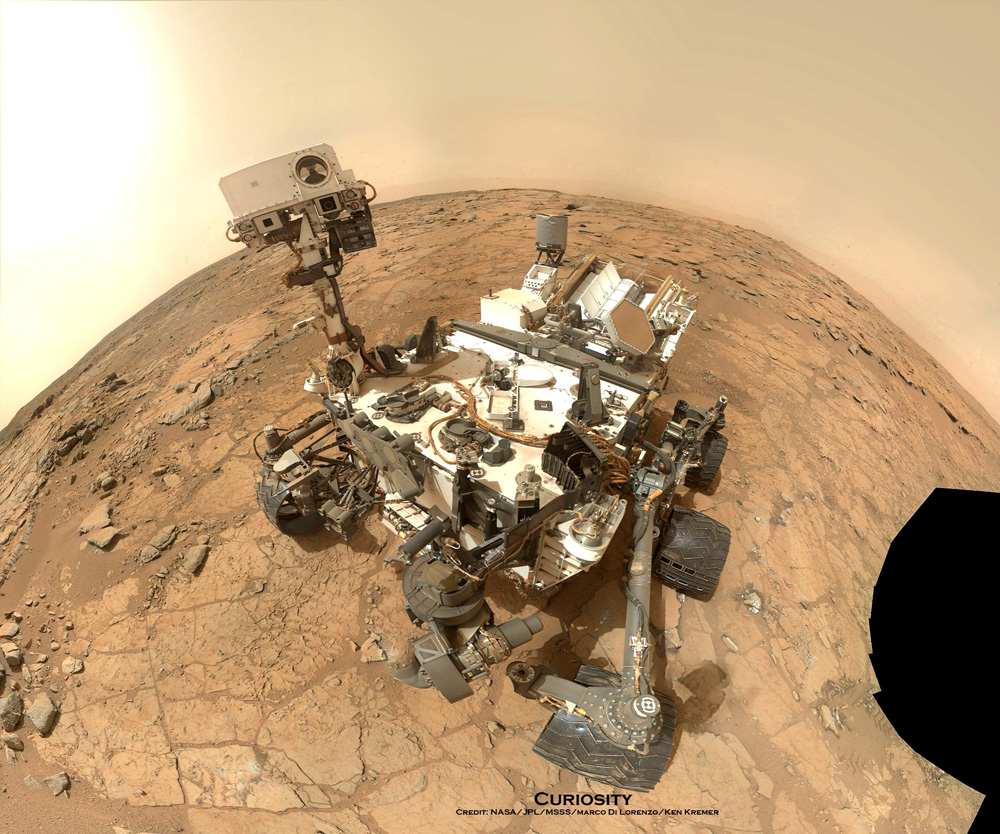
After cooling its heels for a month on the Red Planet, NASA's Mars rover Curiosity is gearing up for lots of action in the coming weeks.
Curiosity's handlers sent no commands to the rover for most of April, because Mars was on the opposite side of the sun from Earth at the time. But this planetary alignment, known as a Mars solar conjunction, is now over, and the mission team is planning to drill into a Red Planet rock soon and then send Curiosity off on an epic, miles-long trek to the base of a huge and mysterious mountain.
"A couple of weeks to move to the site and drill, and then the experiments themselves can take also a couple of weeks — that's about the time scale we're looking at," said Curiosity deputy project scientist Ashwin Vasavada, of NASA's Jet Propulsion Laboratory in Pasadena, Calif. "And then we'd hopefully get going." [Curiosity's Latest Amazing Mars Photos]
He stressed, however, that this timeframe could shift depending on how the drilling operation goes, and what Curiosity discovers.
Curiosity healthy after 'spring break'
The Curiosity rover wasn't idle during conjunction. It continued monitoring Martian weather and radiation and perfomed some relatively simple science work using commands sent up in advance, Vasavada said.
"That all went fine — it kind of executed flawlessly a long set of preplanned activities," he told SPACE.com. "We had never planned 30 days at once [before], so that was a relief."
Sign up for the Live Science daily newsletter now
Get the world’s most fascinating discoveries delivered straight to your inbox.
But things have picked up since mission controllers got back in touch with Curiosity late last week. They've already uploaded a minor software update to the rover, which emerged from conjunction in fine health, Vasavada said.
Curiosity continues to operate on its backup, or B-side, computer, which it switched to after a glitch knocked out its primary computer (or A-side) in late February.
The rover team has still not fully figured out what happened to the A-side, but engineers have made significant troubleshooting progress. For example, Curiosity would have been OK if an issue during conjunction had forced the rover to swap back over to the A-side computer, Vasavada said.
Drilling another hole
Curiosity touched down inside Mars' huge Gale Crater last August, kicking off a two-year surface mission to determine if the Red Planet could ever have supported microbial life.
The rover team has already checked off this primary goal, announcing in March that a spot dubbed Yellowknife Bay was indeed habitable billions of years ago. Scientists reached this conclusion after studying Curiosity's analyses of material pulled from a 2.5-inch-deep (6.4 centimeters) hole the rover drilled into a Red Planet outcrop. [Ancient Mars Could Have Supported Life (Photos)]
Now that conjunction's over, the mission team wants to drill another hole in a nearby rock, to confirm and perhaps extend the exciting results gleaned from the first drilling activity.
"Probably in the next week or two, we will slightly move the rover to a new location, which the science team is actively choosing right now," Vasavada said. "Primarily, it will be to duplicate the results from the first hole, because they were so exciting and, in some cases, unexpected that the people who run the experiments just want to make sure it's really correct before writing all the papers up."
"Slightly move" likely means a few meters or so, he said, adding that the second drilling activity might target intriguing mineral veins or concretions that the team avoided the first time around, not wanting to complicate the drill's maiden operation.
Off to Mount Sharp
Once the drilling and subsequent analyses are complete, the team plans to start the long trek to Mount Sharp, the mysterious 3.4-mile-high (5.5 kilometers) mountain that rises from Gale Crater's center.
Mount Sharp's foothills, which lie about 5 miles (8 km) away from Yellowknife Bay, were identified as Curiosity's main destination before the rover's November 2011 launch.
Mars-orbiting spacecraft have spotted signs that the mountain's base was exposed to liquid water long ago, and the team wants Curiosity to read the Red Planet's environmental history like a book as it climbs up Mount Sharp's lower reaches.
Curiosity has taken plenty of time to check out interesting rocks and riverbeds near its landing site thus far, putting just 2,300 feet (700 meters) on its odometer to date. But the long trip to Mount Sharp will force a shift in the rover team's mindset, requiring them to ignore some intriguing features in the interest of making tracks.
Mission scientists are already starting to plan Curiosity's route to Mount Sharp, a process that involves identifying high-priority science targets along the way. Still, there's no way the team will be able to look at everything that draws their interest.
"One of our engineers said it's like putting your family in the car to go to Disneyland," Vasavada said. "Along the way, there's the biggest ball of twine, and a little dinosaur museum and all this stuff. But you have to tell your kids, 'We can't do everything, or we'll never get to Disneyland.'"
This story was provided by SPACE.com, a sister site to Live Science. Follow Mike Wall on Twitter @michaeldwall and Google+. Follow us @Spacedotcom, Facebook or Google+. Originally published on SPACE.com.











